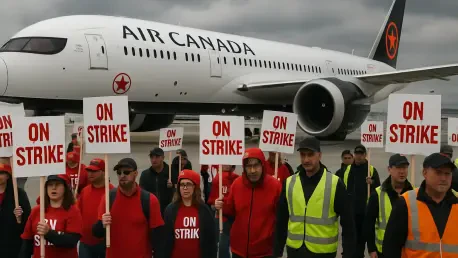What happens when the heartbeat of a nation’s aviation industry stops, leaving thousands stranded and a major airline in chaos? On August 16, 2025, over 10,000 Air Canada flight attendants, backed by the Canadian Union of Public Employees (CUPE), walked off the job, igniting a labor dispute that has paralyzed the skies. Within days, the Canada Industrial Relations Board (CIRB) branded the strike unlawful, thrusting passengers, employees, and the airline into a storm of legal and logistical turmoil. This clash isn’t just about grounded planes; it’s a battle over rights, regulations, and the very fabric of essential services in Canada.
The significance of this standoff extends far beyond airport terminals. Air Canada, a vital artery for Canadian travel, connects millions annually for business, family, and leisure. With an estimated 500,000 passengers disrupted by flight cancellations, the ruling affects not only individual plans but also the airline’s financial stability and public perception. This case serves as a critical test of how labor disputes are managed in industries deemed essential, raising questions about the balance between workers’ rights and legal obligations. It’s a story that demands attention from travelers, policymakers, and labor advocates alike.
A Labor Clash That Stopped the Skies
The spark of this crisis ignited on August 16, when CUPE-led flight attendants initiated a strike, halting operations at Air Canada and Air Canada Rouge. The move was a bold statement from the union, representing a workforce integral to the airline’s daily functions. However, the CIRB quickly intervened, declaring the action unlawful after a pivotal hearing on August 17, citing a breach of industrial relations protocols.
This wasn’t just a minor hiccup; the ruling sent shockwaves through the industry. The board issued strict mandates for CUPE to end the strike and for union leaders to instruct members to return to work. A public notice revoking the strike was ordered by noon EDT on August 18, yet defiance from the union has kept tensions high. Flights remain canceled until at least the afternoon of August 19, leaving travelers in limbo and the airline scrambling to manage the fallout.
The human toll is evident at every airport gate. Passengers, expecting seamless journeys, now face endless delays and uncertainty. Air Canada Express flights, operated by Jazz or PAL, are the only lifeline still running, but they can’t shoulder the full load. This operational paralysis underscores the stakes of the dispute, painting a vivid picture of a system under strain.
Ripple Effects Felt by Millions
Beyond the immediate chaos, the CIRB’s decision reverberates through Canada’s economic and social landscape. Air Canada isn’t just an airline; it’s a cornerstone of national connectivity, facilitating commerce and personal ties. With half a million travelers affected, the disruptions have led to missed business deals, canceled vacations, and emotional distress for those separated from loved ones.
Financially, the airline faces a steep climb. On July 28, Air Canada suspended its third-quarter and full-year operating results guidance for 2025, signaling deep uncertainty. This move reflects the impossibility of predicting performance amid such upheaval, potentially shaking investor confidence and straining community relations. The long-term impact on the airline’s reputation remains a looming concern.
For the public, trust in air travel hangs in the balance. Social media buzzes with passenger frustrations over unplanned expenses and lost time, highlighting a broader anxiety about relying on essential services during labor conflicts. This situation exposes vulnerabilities in the system, prompting a reevaluation of how such disputes affect everyday lives.
Legal Verdict and Lingering Defiance
Diving into the CIRB’s rationale, the ruling stems from a clear violation of established labor protocols, though specific details of the breach remain outside this narrative’s scope. The board’s orders were unequivocal: CUPE must halt strike activities, leaders must direct members back to work, and individual flight attendants must resume duties. Non-compliance, however, has fueled an ongoing crisis, with no flights operating for Air Canada’s main and Rouge divisions.
The aftermath paints a grim picture of logistical gridlock. With cancellations persisting, the airline has rolled out measures like refunds, travel credits, and rebooking options on other carriers. Customers are urged to avoid airports unless confirmed on alternative flights, a stark reminder of the scale of disruption. Notifications have been sent to keep travelers informed, but solutions feel like temporary bandages on a deeper wound.
This defiance from CUPE adds a layer of complexity. While the union’s reasons for resisting the CIRB mandate aren’t publicly detailed here, their stance prolongs the standoff. The clash between legal authority and union resolve sets a precedent for future disputes, challenging the mechanisms designed to maintain order in critical sectors.
Voices Echoing from the Chaos
Air Canada has voiced regret over the widespread inconvenience, emphasizing efforts to support affected customers through flexible policies and constant updates. Statements from the airline reflect a commitment to mitigating damage, though the path to normalcy remains unclear. The silence from CUPE, on the other hand, leaves a gap in understanding the full scope of motivations behind their continued resistance.
Passenger stories add a raw, human dimension to the crisis. Social media platforms are rife with accounts of missed flights leading to shattered plans—weddings unattended, critical meetings skipped, and unexpected costs piling up. One traveler’s post about spending hundreds on last-minute accommodations captures the tangible burden placed on ordinary people caught in this crossfire.
Expert perspectives, while not directly quoted here, often frame such rulings as necessary to uphold structure in essential industries. Labor law analysts might argue that the CIRB’s decision reinforces the importance of legal compliance over unilateral action. These insights, paired with firsthand accounts, weave a narrative of frustration and principle, illustrating the multifaceted impact of the strike.
Charting a Path Through the Turbulence
For those entangled in this mess, actionable steps offer some relief. Passengers are advised to monitor flight statuses online and accept refunds or rebooking options provided by Air Canada to lessen the blow. Avoiding airports unless rebooked on other airlines is a practical tip to dodge further frustration, while considering Air Canada Express routes could be a viable workaround.
Air Canada faces the daunting task of enforcing the CIRB’s mandate, potentially through escalated legal measures or backchannel negotiations with CUPE to address root grievances. Restoring operations is paramount, but so is rebuilding trust with a disgruntled customer base. Transparent communication and swift resolution will be key to salvaging the airline’s standing.
On a broader scale, this incident nudges policymakers and labor advocates to rethink frameworks for managing strikes in vital sectors. Striking a balance between protecting workers’ rights and ensuring public service continuity emerges as a pressing need. Stakeholders across the board are left to ponder how to prevent such paralyzing conflicts in the future, with lessons from this crisis guiding potential reforms.
Looking back, the Air Canada strike of August 2025 stands as a stark reminder of the fragility of essential services when labor and law collide. The CIRB’s ruling, though legally sound, couldn’t immediately quell the unrest, leaving passengers and the airline to bear the brunt. As the dust settles, the focus shifts to proactive measures—strengthening dialogue between unions and regulators, enhancing contingency plans for travelers, and fortifying policies to avert similar crises. The path forward demands collaboration, ensuring that the skies remain open without sacrificing the voices of those who keep them running.









